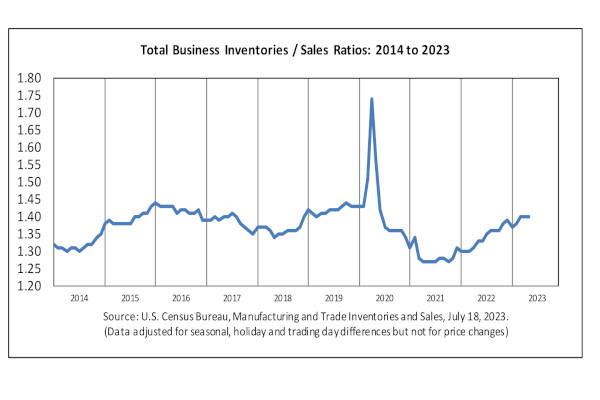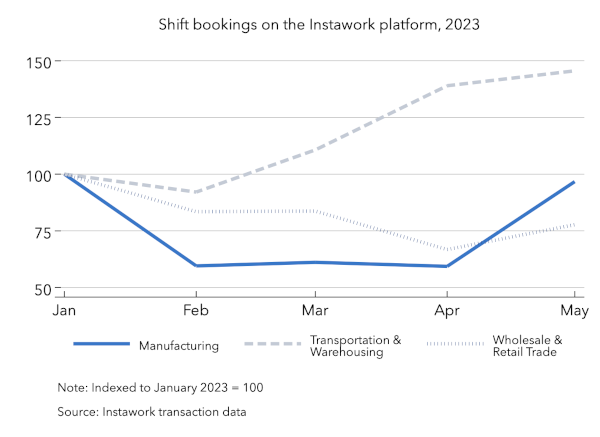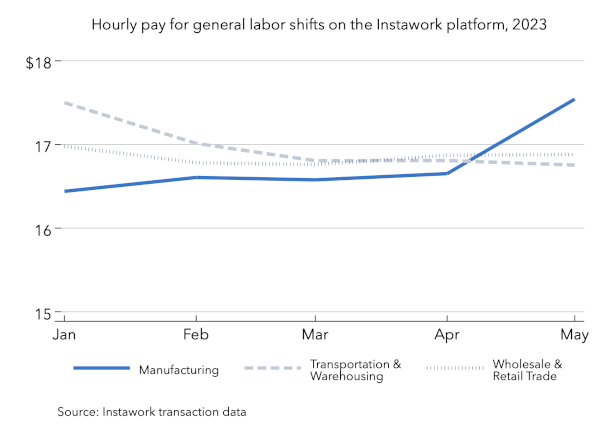Whether the U.S. economy is in recession, heading into one, or coming out of one, has been hotly debated for the past year. The post-COVID recovery has created a fluctuations in economic data unlike anything economists have ever seen. As a result, making determinations on the state of the economy has been difficult at best.
While retail sales have continued to rise, up 0.3% in June from May and 1.5% in June year-over-year, the increase is the weakest since May 2020, according to the Commerce Department. The Institute for Supply Management (ISM) said the services economy activity grew again in June, with the Services PMI up 3.6% to a reading of 53.9, indicative of growth. Manufacturing, on the other hand, declined slightly in June, to a reading of 46, down 0.9% month over month, ISM said.

Data from flexible work platform Instawork suggests the supply chain may be ready to break out, with pay rising and the demand for labor increasing in the manufacturing sector. With businesses having worked down inventories from COVID-induced highs, it appears some are starting to ramp back up again. The U.S. Census Bureau’s total business inventories to sales ratios improved 0.2% in May over April. While up, that ratio is still down 1.8% from May 2022.
According to Instawork data compiled by Chief Economist Daniel Altman, the record inventories drove down hours for workers as manufacturers curtailed production. That is starting to change, particularly for west coast manufacturers.
The company said that transportation and warehousing shifts have been growing since March, and flexible labor requests have increased in the wholesale and retail trade sectors as well.

Hourly pay is also rising in manufacturing, with May’s numbers increasing closer to $18 per hour from below $17 in April. Pay in transportation and warehousing and wholesale and retail trade remained mostly flat month-over-month.
Altman told Supply Chain Management Review that as the economy reopened in earnest in 2022, people started spending on services and experiences. “At that point, demand for goods really stalled and that caught many companies flat-footed,” he says.
That surge is mostly over, bloated inventories have fallen, and people are again starting to demand goods.
“From a purely economic perspective, the second half of this year looks like it is going to be a lot more normal compared to pre-pandemic [times],” Altman says.
According to Instawork, manufacturing labor demand has taken a big jump our west, with Phoenix leading the way. Manufacturing shifts in the Phoenix area quadrupled in May from January’s level. The Bay Area, which the company describes as its most mature market, saw an increase of 50%.
The trends in the rest of the country are more muted. In the Midwest, labor demand has matched the national trend, with a seasonal dip and now a small recovery. Chicago could be poised to benefit as labor supply remains tight in the region. The company sees no immediate manufacturing recovery in the East, especially the Atlanta and Philadelphia regions.
“So, it’s possible that a manufacturing recovery might be led by tech-focused businesses, moving from west to east as activity snowballs in the entire sector. We should see a more even trend by the end of this year, when the holiday season is likely to follow pre-pandemic norms more closely than in any of the past few years,” the company wrote in a blog post.
Altman says that Instawork’s platform has closely mirrored the general economy in the past, so he is viewing what they are seeing as a positive sign for the economy.
“We found the shift on our platform for flexible workers is a good leading indicator, in fact, they are pretty much in synch with traditional indicators in the supply chain and that’s because when demand starts to pick up it’s hard for businesses to [hire immediately],” Altman notes.
Overall, Instawork said the two weeks of data starting June 22 saw a 6 cent per hour increase in pay compared to the previous two-week period. There was a 1.7% drop in share of short-notice shifts and a 2.4 hours drop in hours per existing worker.
Altman points out that while hours per worker dropped, that isn’t necessarily indicative of a decline in productivity. In fact, it is often because there are more workers available. He says Instawork’s platform now has close to 5 million workers with availability, compared to 3 million a year ago.
While unemployment has remained relatively stable during this time, Altman says the increase is likely due to more people looking for flexible work arrangements or second jobs.
“There is no doubt that for a large number of workers it is supplemental income,” he says. “And it’s also flexibility. We have heard from some of our partners and other businesses that people who used to work six days a week now want to work five days a week. They are still working that sixth day, they just want that extra flexibility.”

One concern is whether the exodus of residents from big cities that took place during the pandemic will hamper businesses in these regions as they seek to expand their workforce. Still, Altman is expecting the second half to show positive momentum for the supply chain.
“If you look around, the stock market is very strong. The Fed, probably by September, will decide to pause rates and people will take that as a very positive [sign] and inflation is already … under 3%. There are a lot of positive signs.”
SC
MR


More Inventory Management
- April manufacturing output slides after growing in March
- World Trade Centers offers a helping hand to create resilient, interconnected supply chains
- Israel, Ukraine aid package to increase pressure on aerospace and defense supply chains
- How S&OP provides the answer to in-demand products
- Shining light on procurement’s dark purchases problem
- ISM reports that services sector sees continued growth in March
- More Inventory Management
Latest Podcast

 Explore
Explore
Topics
Procurement & Sourcing News
- April manufacturing output slides after growing in March
- World Trade Centers offers a helping hand to create resilient, interconnected supply chains
- Bridging the ESG gap in supply chain management: From ambition to action
- Israel, Ukraine aid package to increase pressure on aerospace and defense supply chains
- How CPG brands can deliver on supplier diversity promises
- How S&OP provides the answer to in-demand products
- More Procurement & Sourcing
Latest Procurement & Sourcing Resources

Subscribe

Supply Chain Management Review delivers the best industry content.

Editors’ Picks




